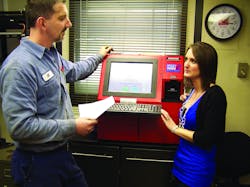Fleet management analysis
With budget cuts, “green” mandates, and aging, overworked facilities, how can municipal and private fleet managers not just cope, but thrive in today’s difficult economy?
Fluid analysis, of course, is vital to the health of all fleet vehicles and equipment. With results as comprehensive as an off-site lab, on-site oil analysis in minutes is helping to cut fleet operation and maintenance cost by enabling real-time diagnosis and repair, minimizing vehicle/crew downtime, and extending oil and vehicle life.
Sending samples to off-site labs takes time. Even 24-hour turnaround from an off-site lab does not factor in the time to ship the sample through the mail, or via overnight delivery (at additional cost to the sender). Off-site labs acknowledge that samples degrade over time. Furthermore, samples that are lost, mishandled or damaged during shipping can also affect the integrity of the results.
Even cumbersome low-end “on-site analysis” doesn’t measure up to the needs of fleet managers. Although there are smaller and less comprehensive testing devices for on-site monitoring on the market, a more comprehensive analysis of multiple factors, including comparisons against expected equipment wear rate curves, was only available through fluid analysis at off-site laboratories. Low-end on-site testing equipment has usually been limited to single tests like viscosity and can introduce false readings if samples must be handled multiple times.
Real-time on-site analysis is now eliminating the wait and costly sampling with equipment that is as easy to use as an ATM. In 12 minutes or less, operators can have comprehensive diagnostic analysis showing oxidation, TBN, metal wear and contamination before equipment loss and downtime become catastrophic, allowing fleet managers to repair their equipment faster and get it back in service more cost effectively than ever.
OSA, prior to its founding, was an independent lab in the 1980s. The technology company was formed to address the market need for faster, comprehensive, laboratory quality testing and soon released its OSA3 TruckCheck® on-site analyzer. Essentially, a “lab in a box,” the on-site analyzer was developed to produce “lab-quality” results with a small footprint and with an easy to use touch screen interface.
There are smaller and less comprehensive testing devices for on-site monitoring available, but these hand-held devices are limited to single tests like viscosity. Furthermore, they do not analyze the information in comparison to known and expected engine wear rate curves and instead operate off estimated values based on user input, which can affect the accuracy of results and even indicate a problem when one does not exist.
OSA has contributed to municipal fleet “Greening” initiatives by providing the physical properties of the oil before it’s changed. OSA has documented that over 70% of the oil changes are unnecessary because the oil still had acceptable physical properties. However, anyone attempting to extend their oil drain interval without a fluids analysis program is playing “Russian Roulette”. The OSA can identify the presence of 20 metals, measure physical properties such as glycol, TBN, soot (diesel engines only), fuel dilution, water, nitration, and oxidation, and also measure viscosity at 40 and 100c. It has an optional integrated particle counter and provides comparisons against expected equipment wear rate curves similar to off-site labs.
After analysis is complete, the equipment delivers an easy to understand diagnostic report that includes suggested preventive steps. The results are instantly emailed as an “Alert” if an abnormal finding is discovered. The data can also be downloaded to a password protected LubeTrak® website for data mining and trending from anywhere in the world. OSA’s LubeTrak® Program, the company’s web-based global fluids monitoring division, allows fleet operators complete, real-time access and control over equipment condition, sampling schedules, and management reporting all from a web browser.
Another way that on-site analysis can save fleets and the environment is by extending oil use beyond antiquated PM practices such as requiring oil changes every 3,000 miles or 90 days, whether needed or not. Over 70% of oil changes done based on time or mileage are not necessary, which can waste valuable technician time, fresh oil, and create unnecessary hazardous waste. Oil analysis, in fact, finds oil to still be in good working condition 82% of the time despite 3,000 mile or time-based recommendations.
OSA meets ASTM international standards for oil analysis and complies with ASTM-D7417-10 “Standard Test Method for Analysis of In-Service Lubricants Using Particular four-Part Integrated Tester.”
